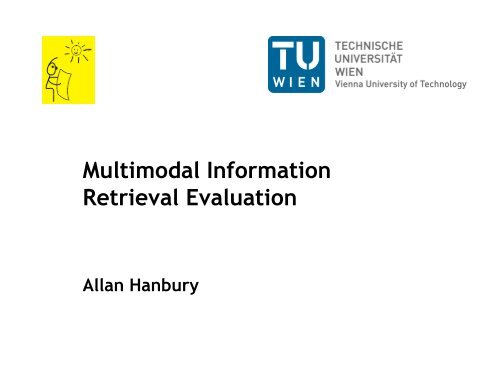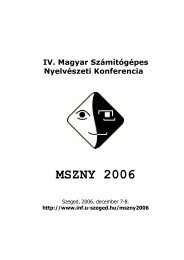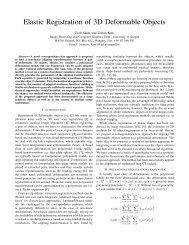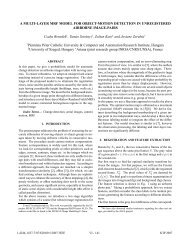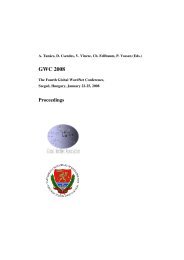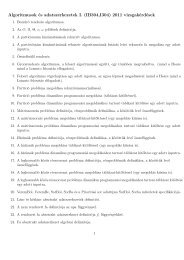Multimodal Information Retrieval Evaluation
Multimodal Information Retrieval Evaluation
Multimodal Information Retrieval Evaluation
Create successful ePaper yourself
Turn your PDF publications into a flip-book with our unique Google optimized e-Paper software.
<strong>Multimodal</strong> <strong>Information</strong><br />
<strong>Retrieval</strong> <strong>Evaluation</strong><br />
Allan Hanbury
Outline<br />
• Introduction<br />
• <strong>Retrieval</strong> effectiveness evaluation<br />
• <strong>Evaluation</strong> campaigns<br />
• User-based evaluation<br />
• Conclusion<br />
2
• Why evaluation?<br />
Introduction<br />
– Because without evaluation, there is no research<br />
• Why is this a research field in itself?<br />
– Because there are many kinds of IR<br />
• With different evaluation criteria<br />
– Because it’s hard<br />
• Why?<br />
– Because it involves human subjectivity (document relevance)<br />
– Because of the amount of data involved (who can sit down<br />
and evaluate 1,750,000 documents returned by Google for<br />
‘university vienna’?)<br />
8
Kinds of evaluation<br />
• “Efficient and effective system”<br />
• Time and space: efficiency<br />
– Generally constrained by pre-development<br />
specification<br />
• E.g. real-time answers vs. batch jobs<br />
• E.g. index-size constraints<br />
– Easy to measure<br />
• Good results: effectiveness<br />
– Harder to define → more research into it<br />
• And…<br />
9
Kinds of evaluation (cont.)<br />
• User studies<br />
– Does a 2% increase in some retrieval performance<br />
measure actually make a user happier?<br />
– Does displaying a text snippet improve usability even<br />
if the underlying method is 10% weaker than some<br />
other method?<br />
– Hard to do<br />
– Mostly anecdotal examples<br />
– IR people don’t like to do it (though it’s starting to<br />
change)<br />
10
Outline<br />
• Introduction<br />
• <strong>Retrieval</strong> effectiveness evaluation<br />
• <strong>Evaluation</strong> campaigns<br />
• User-based evaluation<br />
• Conclusion<br />
11
Measures:<br />
Precision and Recall<br />
• The search engine returns a list of results<br />
• How do you know how good these results<br />
are?<br />
• There are two key concepts in measuring this:<br />
precision and recall<br />
12
Precision and Recall<br />
• A query returns n ranked documents from a<br />
database of many.<br />
• Each one is judged as relevant or not:<br />
Rank<br />
1 YES<br />
2 YES<br />
3 NO<br />
4 YES<br />
5 NO<br />
…<br />
n<br />
Relevant<br />
NO<br />
13
Precision and Recall concepts<br />
All Documents<br />
Relevant<br />
Documents<br />
Retrieved<br />
Documents<br />
• Precision = Recall =<br />
14
<strong>Retrieval</strong> effectiveness<br />
• Precision<br />
– How happy are we with what we’ve got?<br />
Precision =<br />
Number of relevant documents retrieved<br />
Number of documents retrieved<br />
• Recall<br />
– How much more could we have had?<br />
Recall =<br />
Number of relevant documents retrieved<br />
Number of relevant documents<br />
15
Intuition for Precision and Recall<br />
• Aim is to find all images of the city Paris indexed by Google<br />
image search.<br />
• How would you expect precision / recall to behave<br />
(roughly)?<br />
Precision<br />
“Paris”<br />
“Paris -Hilton”<br />
“Parijs”<br />
Recall<br />
“Paris France”<br />
16
Important<br />
• Quoting Precision or Recall on their own do<br />
not make sense.<br />
• How can you obtain a recall of 1.0?<br />
– Return all the documents in the database.<br />
• How can you make the precision as high as<br />
possible?<br />
– Return only a few documents.<br />
17
<strong>Retrieval</strong> effectiveness<br />
• Tools we need:<br />
– A set of documents (the “dataset”)<br />
– A set of questions/queries/topics<br />
– For each query, and for each document, a<br />
decision: relevant or not relevant<br />
• Let’s assume for the moment that’s all we<br />
need and that we have it<br />
18
<strong>Retrieval</strong> effectiveness<br />
• Precision and Recall generally plotted as a<br />
“Precision-Recall curve”<br />
1<br />
# retrieved documents increases<br />
precision<br />
0<br />
1<br />
recall<br />
• They do not play well together<br />
19
Precision-Recall curves<br />
• How to build a Precision-Recall Curve?<br />
– For one query at a time<br />
– Make checkpoints on the recall-axis<br />
1<br />
precision<br />
0<br />
recall<br />
1<br />
20
Precision-Recall curves<br />
• How to build a Precision-Recall Curve?<br />
– For one query at a time<br />
– Make checkpoints on the recall-axis<br />
1<br />
precision<br />
0<br />
recall<br />
1<br />
21
Precision-Recall curves<br />
• How to build a Precision-Recall Curve?<br />
– For one query at a time<br />
– Make checkpoints on the recall-axis<br />
– Repeat for all queries<br />
1<br />
precision<br />
0<br />
recall<br />
1<br />
22
• Examples of Precision-Recall curves<br />
<strong>Retrieval</strong> of images of a specific object from a database of images.<br />
From: http://www.robots.ox.ac.uk/~vgg/research/mkdb/<br />
23
• Which results are better?<br />
Text only<br />
Text and Image Features<br />
24<br />
From: http://www.robots.ox.ac.uk/~vgg/research/mkdb/
Precision-Recall curves<br />
• The average is the system’s P-R curve<br />
1<br />
# retrieved documents increases<br />
precision<br />
0<br />
recall<br />
• We can compare systems by comparing the<br />
curves<br />
1<br />
25
<strong>Retrieval</strong> effectiveness<br />
• What if we don’t like this twin-measure approach?<br />
• A solution: F-measure<br />
– Weighted harmonic mean<br />
F<br />
precision⋅<br />
recall<br />
=<br />
2⋅<br />
precision<br />
+<br />
recall<br />
– General form for non-negative real β is<br />
F<br />
β<br />
(<br />
2<br />
1+<br />
β )<br />
=<br />
2<br />
β<br />
⋅<br />
⋅ precision⋅recall<br />
precision+<br />
recall<br />
• F 2 weights recall twice as much as precision<br />
• F 0.5 weights precision twice as much as recall<br />
26
<strong>Retrieval</strong> effectiveness<br />
• Not quite done yet…<br />
– When to stop retrieving?<br />
• Both P and R imply a cut-off value<br />
– How about graded relevance?<br />
• Some documents may be more relevant to the question<br />
than others<br />
– How about ranking?<br />
• A document retrieved at position 1,234,567 can still be<br />
considered useful?<br />
– Who says which documents are relevant and<br />
which not?<br />
27
Single-value measures<br />
• What if we want to compare systems at query<br />
level?<br />
precision<br />
1 • Could we have just one<br />
measure, to avoid the curves?<br />
• Note that the F-measure still<br />
doesn’t solve this (it<br />
depends on the cutoff<br />
value)<br />
0<br />
recall<br />
1<br />
28
Single-value measures<br />
• Average precision<br />
– For each query:<br />
• Every time a relevant document is retrieved, calculate<br />
precision<br />
• Average with previously calculated values<br />
• Repeat until all relevant documents retrieved<br />
– For each system:<br />
• Compute the mean of these averages: Mean Average<br />
Precision (MAP) – one of the most used measures<br />
• R-precision<br />
– Precision at R, where R is the number of relevant<br />
documents.<br />
29
• P(n) – Precision at n documents<br />
– Precision when n documents have<br />
been retrieved<br />
• Average Precision (AP) emphasizes returning<br />
more relevant documents earlier:<br />
rel(r) is 1 if the document at<br />
rank r is relevant, 0 otherwise<br />
AP<br />
=<br />
N<br />
∑<br />
r = 1<br />
number of<br />
[ P( r) × rel( r)<br />
]<br />
relevant documents<br />
• Mean Average Precision (MAP) is the mean of the<br />
AP’s for a group of queries<br />
30
• Example: 4 relevant documents, N=5<br />
documents were retrieved:<br />
Rank<br />
1 YES<br />
2 YES<br />
3 NO<br />
4 YES<br />
5 NO<br />
AP<br />
=<br />
Relevant<br />
N<br />
∑<br />
r = 1<br />
number of<br />
[ P( r) × rel( r)<br />
]<br />
Precision = 0.6<br />
Recall = 0.75<br />
relevant documents<br />
3<br />
1×<br />
1+<br />
1×<br />
1+<br />
2 0<br />
3<br />
3<br />
× +<br />
4<br />
× 1+<br />
5<br />
AP =<br />
4<br />
× 0<br />
=<br />
11<br />
16<br />
=<br />
0.6875<br />
31
<strong>Retrieval</strong> effectiveness<br />
• Not quite done yet…<br />
– When to stop retrieving?<br />
• Both P and R imply a cut-off value<br />
– How about graded relevance<br />
• Some documents may be more relevant to the question than<br />
others<br />
– How about ranking?<br />
• A document retrieved at position 1,234,567 can still be<br />
considered useful?<br />
– Who says which documents are relevant and which<br />
not?<br />
32
Cumulative Gain<br />
• For each document d, and query q, define<br />
rel(d,q) >= 0<br />
• The higher the value, the more relevant the document is to<br />
the query<br />
• Example: (5, 2, 4, 5, 5, 1, 0, 2, 4, …)<br />
• Pitfalls:<br />
– Graded relevance introduces even more ambiguity in<br />
practice<br />
– With great flexibility comes great responsibility to<br />
justify parameter values<br />
p<br />
∑<br />
CG<br />
p<br />
= rel i<br />
i=<br />
1<br />
33
<strong>Retrieval</strong> effectiveness<br />
• Not quite done yet…<br />
– When to stop retrieving?<br />
• Both P and R imply a cut-off value<br />
– How about graded relevance<br />
• Some documents may be more relevant to the question than<br />
others<br />
– How about ranking?<br />
• A document retrieved at position 1,234,567 can still be<br />
considered useful?<br />
– Who says which documents are relevant and which<br />
not?<br />
34
Discounted Cumulative Gain<br />
• A system that returns highly relevant documents<br />
at the top of the list should be scored higher than<br />
one that returns the same documents lower in<br />
the ranked list<br />
DCG<br />
p<br />
=<br />
p<br />
∑<br />
2<br />
log<br />
rel<br />
−<br />
1<br />
i<br />
( )<br />
i= 1 2<br />
1+<br />
• Other formulations also possible<br />
• Neither CG, nor DCG can be used for comparison!<br />
(depend on # rel documents per query)<br />
i<br />
35
Normalised Discounted Cumulative<br />
Gain<br />
• Compute DCG for the optimal return set<br />
E.g.: for a returned set:<br />
(5,3,5,4,2,0,1,1,5,4,2,2,1,3,3,3,1,0,1,1,0,0..)<br />
The following:<br />
(5,5,5,4,4,3,3,3,3,2,2,2,1,1,1,1,1,1,0,0,0,0..)<br />
has the Ideal Discounted Cumulative Gain: IDCG<br />
• Normalise:<br />
nDCG =<br />
p<br />
DCG<br />
IDCG<br />
p<br />
p<br />
36
Other measures<br />
• There are tens of IR measures!<br />
• trec_eval is a little program that computes<br />
many of them<br />
– 37 in v9.0, many of which are multi-point (e.g.<br />
Precision @10, @20…)<br />
• http://trec.nist.gov/trec_eval/<br />
• “there is a measure to make anyone a winner”<br />
– Not really true, but still…<br />
37
Other measures<br />
• How about correlations between measures?<br />
P(30) R-Prec MAP .5 prec R(1,1000) Rel Ret MRR<br />
P(10) 0.88 0.81 0.79 0.78 0.78 0.77 0.77<br />
P(30) 0.87 0.84 0.82 0.80 0.79 0.72<br />
R-Prec 0.93 0.87 0.83 0.83 0.67<br />
MAP 0.88 0.85 0.85 0.64<br />
.5 prec 0.77 0.78 0.63<br />
R(1,1000) 0.92 0.67<br />
Rel ret 0.66<br />
• Kendal Tau values<br />
• From Voorhees and Harman,2004<br />
• Overall they correlate<br />
38
<strong>Retrieval</strong> effectiveness<br />
• Not quite done yet…<br />
– When to stop retrieving?<br />
• Both P and R imply a cut-off value<br />
– How about graded relevance<br />
• Some documents may be more relevant to the question than<br />
others<br />
– How about ranking?<br />
• A document retrieved at position 1,234,567 can still be<br />
considered useful?<br />
– Who says which documents are relevant and which<br />
not?<br />
39
Relevance assessments<br />
• Ideally<br />
– Sit down and look at all documents<br />
• Practically<br />
– The ClueWeb09 collection has<br />
• 1,040,809,705 web pages, in 10 languages<br />
• 5 TB, compressed. (25 TB, uncompressed.)<br />
– No way to do this exhaustively<br />
– Look only at the set of returned documents<br />
• Assumption: if there are enough systems being tested<br />
and not one of them returned a document – the<br />
document is not relevant<br />
40
Relevance assessments - Pooling<br />
• Start with result lists retrieved by multiple systems<br />
(runs)<br />
• Combine the results retrieved by all systems<br />
• Choose a parameter k (typically 100)<br />
• Choose the top k documents as ranked in each<br />
submitted run<br />
• The pool is the union of these sets of docs<br />
– Between k and (# submitted runs) × k documents in pool<br />
– (k+1) st document returned in one run either irrelevant or<br />
ranked higher in another run<br />
• Give pool to judges for relevance assessments<br />
41
From Donna Harman<br />
42
Relevance assessments - Pooling<br />
• Conditions under which pooling works<br />
[Robertson]<br />
– Range of different kinds of systems, including<br />
manual systems<br />
– Reasonably deep pools (100+ from each system)<br />
• But depends on collection size<br />
– The collections cannot be too big<br />
• Big is so relative…<br />
43
Relevance assessments - Pooling<br />
• Advantage of pooling:<br />
– Fewer documents must be manually assessed for<br />
relevance<br />
• Disadvantages of pooling:<br />
– Can’t be certain that all documents satisfying the<br />
query are found (recall values may not be accurate)<br />
– Runs that did not participate in the pooling may be<br />
disadvantaged<br />
– If only one run finds certain relevant documents, but<br />
ranked lower than 100, it will not get credit for these.<br />
44
Relevance assessments<br />
• Pooling with randomized sampling<br />
• As the data collection grows, the top 100 may not<br />
be representative of the entire result set<br />
– (i.e. the assumption that everything after is not<br />
relevant does not hold anymore)<br />
• Add to the pool a set of documents randomly<br />
sampled from the entire retrieved set<br />
– If the sampling is uniform easy to reason about, but<br />
may be too sparse as the collection grows<br />
– Stratified sampling: get more from the top of the<br />
ranked list<br />
45
Outline<br />
• Introduction<br />
• <strong>Retrieval</strong> effectiveness evaluation<br />
• <strong>Evaluation</strong> campaigns<br />
• User-based evaluation<br />
• Conclusion<br />
46
How does a typical<br />
evaluation campaign run?<br />
• Take ImageCLEF as a “typical” evaluation campaign<br />
• http://www.imageclef.org<br />
• In 2008, it consisted of 5 tasks:<br />
– photographic retrieval task,<br />
– medical retrieval task,<br />
– general photographic concept detection task,<br />
– medical automatic image annotation task, and<br />
– image retrieval from a collection of Wikipedia articles.<br />
• We will look at the ImageCLEF 2007 photographic<br />
retrieval task<br />
• Opportunity to combine text and visual retrieval<br />
algorithms<br />
47
Circle of events<br />
Proceedings<br />
publication<br />
Call for<br />
participation<br />
Task<br />
definition<br />
TREC<br />
conference<br />
Document<br />
procurement<br />
Results<br />
analysis<br />
Topic<br />
definition<br />
Results<br />
evaluation<br />
Relevance<br />
assessments<br />
IR<br />
experiments<br />
48
1. Call for Participation<br />
• Flyer<br />
• Web<br />
49
2. Task definition<br />
• This new challenge allows for the investigation of<br />
the following research questions:<br />
– Are traditional text retrieval methods still applicable<br />
for such short captions?<br />
– How significant is the choice of the retrieval language?<br />
– How does the retrieval performance compare to<br />
retrieval from collections containing fully annotated<br />
images (ImageCLEFphoto 2006 )?<br />
– Has the general retrieval performance improved in<br />
comparison with retrieval from lightly annotated<br />
images (ImageCLEFphoto 2006 )?<br />
50
3. Data procurement<br />
• Get a database of images suitable for the task<br />
• Considerations:<br />
– Copyright restrictions<br />
– Size<br />
– Quality<br />
– Annotations<br />
– Are realistic queries possible?<br />
• Data drives what can actually be evaluated<br />
• Cannot use the same dataset for too long<br />
51
• In ImageCLEF 2006–2008, used the<br />
IAPR TC-12 image dataset<br />
• Images provided by Viventura, a travel<br />
company<br />
• Travel guides take photos on tours and upload<br />
them to the company website<br />
• Each image annotated in English, German and<br />
Spanish by Michael Grubinger<br />
• In 2007, the description field was omitted to<br />
make it more difficult to search purely using<br />
text<br />
52
IAPR-TC12 example image<br />
title<br />
photo id<br />
originator<br />
description<br />
notes<br />
date<br />
location<br />
53
4. Topic/Query definition<br />
• Want to have realistic queries/topics<br />
• Type of queries limited by the database used<br />
• More topics lead to more confidence in the<br />
experimental results – 50 topics is a<br />
commonly used number<br />
• A query log file of a search engine is often a<br />
good source of realistic queries<br />
54
ImageCLEFphoto query<br />
topic background<br />
55
Queries<br />
• Offered in<br />
16<br />
languages<br />
(particular<br />
to CLEF):<br />
56
Typical query example<br />
<br />
Number: 4 <br />
group in front of mountain landscape <br />
Relevant images will show a group of at least<br />
three people in front of a mountain landscape. Images<br />
with a single person or a couple are not relevant,<br />
and images that do not show at least two mountains in<br />
the background are not relevant either. <br />
images/03/3474.jpg <br />
images/09/9882.jpg <br />
images/23/23221.jpg <br />
<br />
Query<br />
Narrative<br />
Example<br />
images<br />
• Narrative aims to help with relevance<br />
judgements, is however often useful for search<br />
too<br />
57
5. IR experiments<br />
• Make the dataset and queries available to the<br />
participants<br />
• Make available a result file format<br />
– For each query, the participant returns a ranked<br />
list of the images that best respond to the query<br />
• Each participant may submit a number of runs<br />
(attempts with different parameters)<br />
– Each run has the retrieval results for all queries<br />
• Set a deadline for submissions<br />
58
6. Relevance assessments<br />
• We need to know the ground truth for every<br />
query<br />
– Which documents are relevant and which not?<br />
– Most often a binary value – relevant/not relevant – is<br />
used, but degrees of relevance are also possible<br />
• Obvious solution is to manually assess every<br />
document for every query<br />
• With 20000 images, 50 queries, ±5 seconds per<br />
image: need 58 days (working 24 hours per day)<br />
• Pooling is used to speed up relevance<br />
assessments<br />
59
7. Results evaluation<br />
• <strong>Evaluation</strong> measures calculated for every<br />
submitted run.<br />
– Precision<br />
– Recall<br />
– Mean Average Precision (MAP)<br />
60
Results for imageCLEFphoto 2007<br />
• 20<br />
participants<br />
Best result for each query and caption language combination<br />
Average results by<br />
retrieval modality
8. Results analysis<br />
• What can you learn from the results?<br />
• Relate to the research questions in step 2<br />
• <strong>Evaluation</strong> measures are only comparable if<br />
the experiments are carried out<br />
– On the same test database<br />
– Using the same set of queries<br />
• Be careful comparing results in different years<br />
62
9. Conference<br />
• Best results, but also interesting approaches<br />
are presented<br />
– Possible dilemma for organisers: What if the best<br />
system is the same as in the previous year?<br />
• Discussion between participants<br />
63
10. Proceedings<br />
64
Outline<br />
• Introduction<br />
• <strong>Retrieval</strong> effectiveness evaluation<br />
• <strong>Evaluation</strong> campaigns<br />
• User-based evaluation<br />
• Conclusion<br />
65
Laboratory experiments<br />
• Abstraction from the real world in well controlled<br />
laboratory conditions<br />
• Goal is retrieval of items of information<br />
• Rigorous testing<br />
• Over-constrained<br />
• Can obtain scientifically reliable results<br />
• But how does this relate to the real world?<br />
– <strong>Information</strong> needs are often related<br />
– Workflow<br />
– ...<br />
66
• Comparison to a tennis racket:<br />
– No evaluation of the device will tell you how well<br />
it will perform in real life – that largely depends on<br />
the user<br />
– But the user will chose the device based on the<br />
lab evaluation<br />
67
User-based evaluation<br />
• Different levels of user involvement<br />
– Based on subjectivity levels<br />
1. Relevant/non-relevant assessments<br />
• Used largely in lab-like evaluation as described before<br />
2. User satisfaction evaluation<br />
• Measures the user’s satisfaction with the system<br />
• Some work on 1., very little on 2.<br />
68
User satisfaction evaluation<br />
• Expensive and difficult to do correctly.<br />
– Large, representative sample of actual users<br />
– Each system must be equally well developed and<br />
have a user interface<br />
– Each participant must be equally well trained on<br />
each system<br />
– The learning effect must be controlled for<br />
• User satisfaction is very subjective<br />
– UIs play a major role<br />
– Search dissatisfaction can be a result of the nonexistence<br />
of relevant documents<br />
69
Beyond the Laboratory: VideOlympics<br />
70
VideOlympics 2007<br />
• TrecVID 2005/2006 data<br />
• Example queries:<br />
Find shots of one or more helicopters in<br />
flight.<br />
Find shots of a hockey rink with at least<br />
one of the nets fully visible from some<br />
point of view.<br />
Find shots of an office setting, i.e., one or<br />
more desks/tables and one or more<br />
computers and one or more people<br />
Find shots of a group including at least four<br />
people dressed in suits, seated, and with at<br />
least one flag.<br />
71
VideOlympics Result Display System<br />
High penalty for<br />
wrong results<br />
One<br />
display<br />
Run ends when<br />
100 results have<br />
been found or 5<br />
minutes have past<br />
TRECVID like queries<br />
A result is submitted as<br />
soon as it is found<br />
……………<br />
<strong>Retrieval</strong> Systems running on Notebooks<br />
72
Conclusion<br />
• IR <strong>Evaluation</strong> is a research field in itself<br />
• Without evaluation, research is pointless<br />
• Most IR <strong>Evaluation</strong> exercises are laboratory<br />
experiments<br />
– As such, care must be taken to match, to the<br />
extent possible, real needs of the users<br />
73
Bibliography<br />
• Modern <strong>Information</strong> <strong>Retrieval</strong><br />
– R. Baeza-Yates, B. Ribeiro-Neto<br />
• TREC – Experiment and <strong>Evaluation</strong> in <strong>Information</strong><br />
<strong>Retrieval</strong><br />
– E. Voorhees, D. Harman (eds.)<br />
• A Comparison of Statistical Significance Tests for<br />
<strong>Information</strong> <strong>Retrieval</strong> <strong>Evaluation</strong><br />
– M. Smucker, J. Allan, B. Carterette (CIKM’07)<br />
• A Simple and Efficient Sampling Method for<br />
Estimating AP and NDCG<br />
– E. Yilmaz, E. Kanoulas, J. Aslam (SIGIR’08)<br />
74
Bibliography<br />
• Do User Preferences and <strong>Evaluation</strong> Measures Line Up?, M. Sanderson and M. L. Paramita and P. Clough<br />
and E. Kanoulas 2010<br />
• A Review of Factors Influencing User Satisfaction in <strong>Information</strong> <strong>Retrieval</strong>, A. Al-Maskari and M. Sanderson<br />
2010<br />
• Towards higher quality health search results: Automated quality rating of depression websites, D. Hawking<br />
and T. Tang and R. Sankaranarayana and K. Griffiths and N. Craswell and P. Bailey 2007<br />
• Evaluating Sampling Methods for Uncooperative Collections, P. Thomas and D. Hawking 2007<br />
• Comparing the Sensitivity of <strong>Information</strong> <strong>Retrieval</strong> Metrics, F. Radlinski and N. Craswell 2010<br />
• Redundancy, Diversity and Interdependent Document Relevance, F. Radlinski and P. Bennett and B.<br />
Carterette and T. Joachims 2009<br />
• Does Brandname influence perceived search result quality? Yahoo!, Google, and WebKumara, P. Bailey and<br />
P. Thomas and D. Hawking 2007<br />
• Methods for Evaluating Interactive <strong>Information</strong> <strong>Retrieval</strong> Systems with Users, D. Kelly 2009<br />
• C-TEST: Supporting Novelty and Diversity in TestFiles for Search Tuning, D. Hawking and T. Rowlands and P.<br />
Thomas 2009<br />
• Live Web Search Experiments for the Rest of Us, T. Jones and D. Hawking and R. Sankaranarayana 2010<br />
• Quality and relevance of domain-specific search: A case study in mental health, T. Tang and N. Craswell and<br />
D. Hawking and K. Griffiths and H. Christensen 2006<br />
• New methods for creating testfiles: Tuning enterprise search with C-TEST, D. Hawking and P. Thomas and T.<br />
Gedeon and T. Jones and T. Rowlands 2006<br />
• Test Collection Based <strong>Evaluation</strong> of <strong>Information</strong> <strong>Retrieval</strong> Systems, M. Sanderson 2010<br />
75


